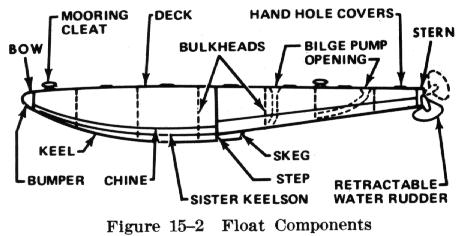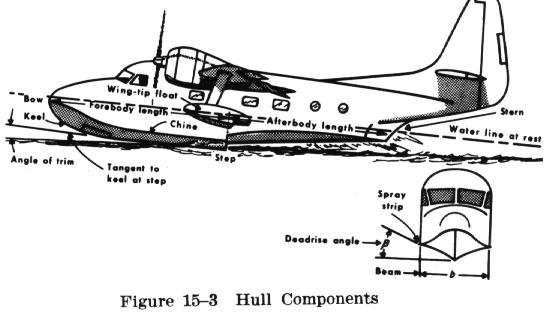
A seaplane is defined as "an airplane designed to take off from and land on water." Seaplanes can be generally classified as either flying boats, or floatplanes. Those that can be operated on both land and water are called amphibians.
The floatplane is ordinarily understood to be a conventional landplane equipped with separate floats instead of wheels, as opposed to a flying boat in which the hull serves the dual purpose of providing buoyancy in the water and space for the pilot, crew, and passengers. The float type is the more common seaplane, particularly those with relatively low horsepower. It may be equipped with either single float or twin floats; however, most seaplanes are the twin float variety. Though there is considerable difference between handling a floatplane and handling a flying boat, the theory on which the techniques are based is similar. Therefore, with few exceptions, the explanations given here for one type may be considered to apply to the other.
In the air the seaplane is operated and controlled in much
the same manner as the landplane, since the only major difference between
the floatplane and the landplane is the installation of floats instead
of wheels. Generally, because of the float's greater weight, replacing
wheels with floats increases the airplane's empty weight and thus decreases
its useful load, and rate of climb.
On many floatplanes, the directional stability will be
affected to some extent by the installation of the floats. This is caused
by the length of the floats and the location of their mass in relation
to the airplane's CG. To help restore directional stability, an auxiliary
fin is often added to the tail. The pilot will also find that less aileron
pressure is needed to hold the floatplane in a slip and holding some rudder
pressure during in-flight turns is usually required. This is due to the
water rudder being connected to the air rudder or rudder pedals by cables
and springs which tend to prevent the air rudder from streamlining in a
turn.

Research and experience have improved float and hull designs throughout the years. Figs. 15-2 and 15-3 illustrate the basic construction of a float and a flying boat. The primary consideration in float construction is the use of sturdy, lightweight material, designed hydrodynamically and aerodynamically for optimum performance.

All floats and hulls now being used have multiple watertight compartments which make the seaplane virtually unsinkable, and prevent the entire float or hull from becoming filled with water in the event it is ruptured at any point.
Both the lateral and longitudinal lines of a float or hull are designed to achieve a maximum lifting force by diverting the water and the air downward. The forward bottom portion of the float (and a hull) is designed very much like the bottom surface of a speedboat. The rearward portion, however, differs significantly from a speedboat.
A speedboat is designed for travel at an almost constant pitch angle and, therefore, the contour of the entire bottom is constructed in approximately a continuous straight line. However, a seaplane float or hull must be designed to permit the seaplane to be rotated or pitched up to increase the wing's angle of attack and gain the most lift for takeoffs and landings. Thus, the underside of the float or hull has a sudden break in its longitudinal lines at the approximate point around which the seaplane rotates into the lift off attitude. This break, called a "step," also provides a means of interrupting the capillary or adhesive properties of the water. The water can then flow freely behind the step, resulting in minimum surface friction so the seaplane can lift out of the water.
The steps are located slightly behind the airplane's center
of gravity, approximately at the point where the main wheels of a landplane
are located. If the steps were located too far aft or forward of this point,
it would be difficult, if not impossible, to rotate the airplane into a
pitch up attitude prior to planing (rising partly out of the water while
moving at high speed) or lift off.
Although steps are necessary, the sharp break along the
float's or hull's underside causes structural stress concentration, and
in flight produces considerable drag because of the eddying turbulence
it creates in the airflow.